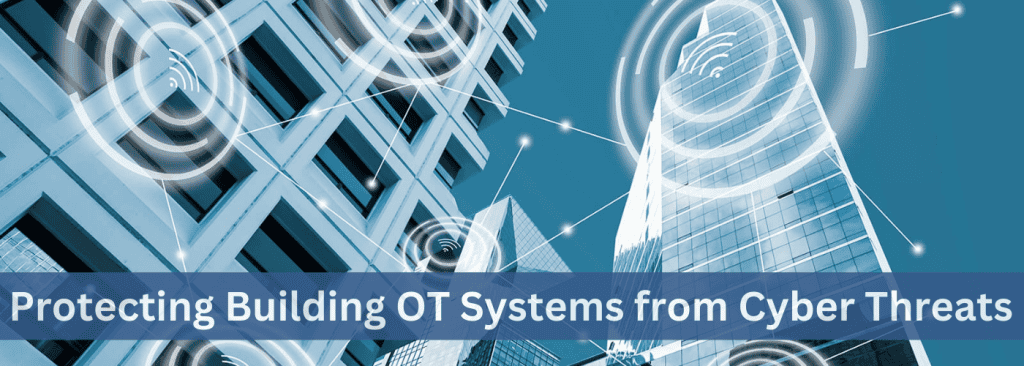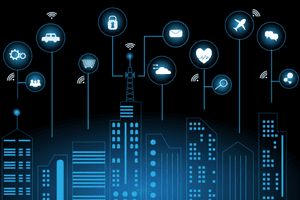Protecting Building OT Systems from Cyber Threats

Operational Technology (OT) systems in buildings, which include HVAC, lighting, access control, and other critical infrastructure, are increasingly becoming targets for cyber threats. The rise in attacks on these systems underscores the importance of robust cybersecurity measures to protect them. Here’s a look at how to safeguard building OT systems from cyber threats.
Understanding the Threat Landscape
Building OT systems are integral to the smooth functioning of modern facilities. However, their increasing connectivity and integration with Information Technology (IT) systems make them vulnerable to cyberattacks. Threats can come from various sources, including nation-state actors, hacktivists, disgruntled employees, and cybercriminals looking to disrupt operations or extract ransom.
Key OT Cybersecurity Measures
Below are recommended key measures to implement to improve cybersecurity for building OT systems. Cybersecurity is a layered approach and implementing all of these may not be possible or practical for every situation.
1. Adopt a Zero Trust Architecture
Zero Trust is a security model that operates on the principle of “never trust, always verify.” It assumes that threats can originate from both outside and inside the network. Implementing a Zero Trust architecture is a foundational, pro-active security model that involves several steps:
– Device Network Authentication: Authenticating that a device is allowed to be on the network.
– Peer-to-Peer Authentication: Authenticating devices to each other so that they many communicate.
– Continuous Monitoring: Regularly assessing and verifying the security posture of users and devices attempting to access the network.
Veridify’s DOME is an example Zero Trust solution for building OT systems.
2. Implement Network Segmentation
Segregate building OT networks from IT networks to minimize the attack surface. This can be achieved through:
– VLANs and Firewalls: Use VLANs to separate different types of traffic and deploy firewalls to control the flow of data between segments.
– DMZ for OT Systems: Create a Demilitarized Zone (DMZ) to isolate building OT systems from the internet and the corporate IT network, allowing only necessary communications.
3. Ensure Strong Identity and Access Management (IAM)
Effective IAM practices are crucial for protecting building OT systems:
– Multi-Factor Authentication (MFA): When possible, require MFA for accessing building OT systems to ensure that only authorized personnel can make changes. Not all building OT systems will support MFA though.
– Role-Based Access Control (RBAC): When possible, implement RBAC to restrict access based on user roles, ensuring that users can only access systems and data relevant to their job functions. Not all building OT systems will support RBAC though.
4. Regularly Update and Patch Systems
Outdated software and firmware are common targets for attackers. Ensure that all building OT systems are regularly updated and patched to close vulnerabilities:
– Automated Patch Management: When possible, use automated tools to manage and deploy patches and software updates across all devices and systems.
– Vendor Coordination: Work closely with equipment vendors to stay informed about security updates and patches.
5. Enhance Monitoring and Incident Response
Continuous monitoring and a robust incident response plan are vital for detecting and responding to threats:
– Intrusion Detection Systems (IDS): Deploy IDS to monitor network traffic for suspicious activity.
– Security Information and Event Management (SIEM): Utilize SIEM solutions to collect and analyze log data from various sources, enabling the detection of anomalies.
– Incident Response Plan: Develop and regularly update an incident response plan that outlines the steps to take in the event of a cyberattack, including communication protocols and recovery procedures.
Note – Monitoring traffic and analyzing logs is a reactive security method and a Zero Trust solution is a proactive security method. With a Zero Trust solution in place, attacks against the building OT systems should be automatically stopped due to lack of authentication.
6. Conduct Regular Security Assessments
Regular security assessments help identify vulnerabilities and areas for improvement:
– Penetration Testing: Conduct regular penetration tests to simulate attacks and identify weaknesses.
– Vulnerability Assessments: Perform routine vulnerability assessments to detect and address potential security gaps.
7. Employee Training and Awareness
Human error is a significant factor in many cyber incidents. Provide comprehensive training and raise awareness among employees about cybersecurity best practices:
– Phishing Simulations: Conduct phishing simulations to educate employees about recognizing and avoiding phishing attacks.
– Security Awareness Programs: Implement ongoing security awareness programs to keep employees informed about the latest threats and safe practices.
Conclusion
Protecting building OT systems from cyber threats requires a multi-faceted approach that includes adopting a Zero Trust architecture, robust network segmentation, strong IAM practices, regular updates and patches, enhanced monitoring, regular security assessments, and comprehensive employee training. By implementing these measures, organizations can significantly reduce the risk of cyberattacks on their OT systems, ensuring the continued safety and functionality of their building infrastructure.
—
Blog Post Summary – All of our recent posts listed on one page






